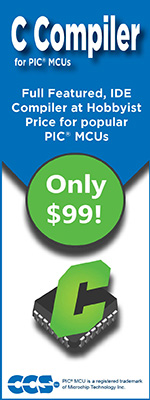Frequently Asked Questions
Why is the RS-232 not working right?
- The PIC® MCU is Sending Garbage Characters.
- Check the clock on the target for accuracy. Crystals are usually not a problem
but RC oscillators can cause trouble with RS-232. Make sure the #USE DELAY
matches the actual clock frequency.
- Make sure the PC (or other host) has the correct baud and parity setting.
- Check the level conversion. When using a driver/receiver chip, such as the
MAX 232, do not use INVERT when making direct connections with resistors
and/or diodes. You probably need the INVERT option in the #USE RS232.
- Remember that PUTC(6) will send an ASCII 6 to the PC and this may not be a
visible character. PUTC('A') will output a visible character A.
- Check the clock on the target for accuracy. Crystals are usually not a problem
but RC oscillators can cause trouble with RS-232. Make sure the #USE DELAY
matches the actual clock frequency.
- The PIC® MCU is Receiving Garbage Characters.
- Check all of the above.
- Nothing is Being Sent.
- Make sure that the tri-state registers are correct. The mode (standard, fast,
fixed) used will be whatever the mode is when the #USE RS232 is encountered.
Staying with the default STANDARD mode is safest.
- Use the following main() for testing:
main() { while(TRUE) putc('U'); }Check the XMIT pin for activity with a logic probe, scope or whatever you can. If you can look at it with a scope, check the bit time (it should be 1/BAUD). Check again after the level converter.
- Nothing is being received.
First be sure the PIC® MCU can send data. Use the following main() for testing:
main() { printf("start"); while(TRUE) putc( getc()+1 );When connected to a PC typing A should show B echoed back. If nothing is seen coming back (except the initial "Start"), check the RCV pin on the PIC® MCU with a logic probe. You should see a HIGH state and when a key is pressed at the PC, a pulse to low. Trace back to find out where it is lost.
- Make sure that the tri-state registers are correct. The mode (standard, fast,
fixed) used will be whatever the mode is when the #USE RS232 is encountered.
Staying with the default STANDARD mode is safest.
- The PIC® MCU is always receiving data via RS-232 even when none is being sent.
- Check that the INVERT option in the USE RS232 is right for your level
converter. If the RCV pin is HIGH when no data is being sent, you should NOT
use INVERT. If the pin is low when no data is being sent, you need to use
INVERT.
- Check that the pin is stable at HIGH or LOW in accordance with A above
when no data is being sent.
- When using PORT A with a device that supports the SETUP_PORT_A
function make sure the port is set to digital inputs. This is not the default. The
same is true for devices with a comparator on PORT A.
- Check that the INVERT option in the USE RS232 is right for your level
converter. If the RCV pin is HIGH when no data is being sent, you should NOT
use INVERT. If the pin is low when no data is being sent, you need to use
INVERT.
- Compiler reports INVALID BAUD RATE.
- When using a software RS232 (no built-in UART), the clock cannot be really
slow when fast baud rates are used and cannot be really fast with slow baud
rates. Experiment with the clock/baud rate values to find your limits.
- When using the built-in UART, the requested baud rate must be within 3% of
a rate that can be achieved for no error to occur. Some parts have internal bugs
with BRGH set to 1 and the compiler will not use this unless you specify
BRGH1OK in the #USE RS232 directive.
- When using a software RS232 (no built-in UART), the clock cannot be really
slow when fast baud rates are used and cannot be really fast with slow baud
rates. Experiment with the clock/baud rate values to find your limits.





